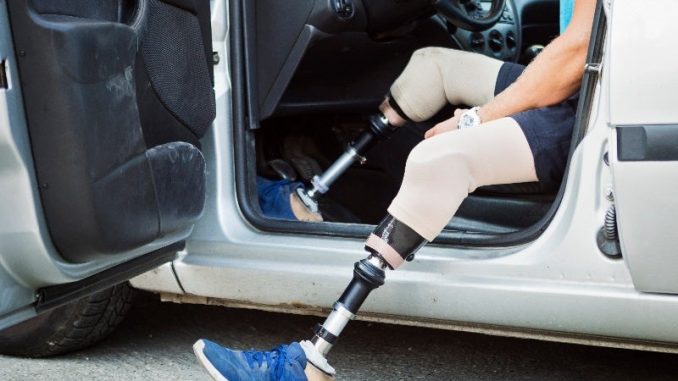
by Ethan Jacobs
Fact-checked with HomeInsurance.com
Some people think a disability might prevent someone from driving, but most of the time that’s not true. Usually, the people making those arguments are unfamiliar with the disabilities in question and the modern technology that is available.
Insurance providers, the very companies that determine how much of a risk a given driver poses, are just as likely to provide coverage for a competent driver with a disability as they are a driver with no disabilities. In fact, since 1990, when the Americans with Disabilities Act (ADA) was made law, discrimination against individuals with disabilities has been outlawed as it relates to transportation.
If you have a disability and are concerned about whether it might affect your ability to get car insurance, you should put your worries to rest. But understand that even with these protections in place, insurance companies base their policies on risk and cost factors. While some of these factors, like the kind of car you drive, your gender and your driving history have nothing to do with your disability, some factors that are considered to a lesser extent are linked to physical handicaps. To make sure you get the best coverage possible, here are some things you should know to keep your costs down.
Getting Car Insurance with A Disability
Though insurance providers cannot discriminate against applicants with disabilities by charging exorbitant premiums, it’s still possible that your disability may require additional coverage. This isn’t always because of the disability itself, but rather because of the upgrades that may be required for your vehicle as a result of your disability. Some disabilities that fall into that category are:
Paralysis: The addition of a wheelchair lift could increase the value of your car, thus increasing your premiums.
Epilepsy or fainting spells: You may be considered a greater risk.
Vision impairment: You may be considered to have added risk.
Hearing impairment: You may have to upgrade your vehicle with alert hearing devices.
Again, in a perfect world, all premiums would be the same, but there are instances where disabilities can cause you to pay higher rates. To protect yourself against this, there are a couple of things that you should consider when looking into car insurance with a disability.
For one, always do your homework. Shopping around for the best quote from multiple insurance providers is the best way to make sure that you’re getting the best value given your circumstances.
Another thing to look out for is a rebate. Often, insurance providers or car manufacturers are willing to work with clients and provide a rebate based on modifications or upgrades made to your vehicle. Though you may end up paying more in premiums, you can offset those expenses with discounts and rebates from your insurer or car manufacturer.
Below are a few other things to keep in mind when seeking out auto insurance as a driver with a disability:
- Most disabled drivers don’t need medical approval to get behind the wheel. Your local DMV will assess your fitness for driving and make a judgment call regarding any limitations that they see fit to put on your license. Having said that, many insurance providers will request written clearance from a medical professional noting that you pose no risk to others.
- If your disability affects your driving, your provider might raise your premium or have you take action to lower the risk that you pose to yourself or others. This may involve further medical attention, outfitting your car with the necessary technology to make you a safer driver or some form of a driver rehabilitation program wherein an occupational therapist will decide the best course of action for you moving forward.
- If you equip your vehicle with expensive technology to facilitate driving with a disability, you may need added insurance. In the event of an accident, the costs to fix or replace such expensive upgrades may not be covered entirely by your existing policy. By increasing your coverage level, you can make sure that you don’t have to pay out of pocket for such costs.
- When looking for an insurance provider, be honest about whether your disability affects your safety. When insurers ask about your medical history or current medical condition, your responses—along with any medical assessment you undergo—impact your premiums. If you are dishonest about your current fitness level and later get in an accident, your provider could drop you if it can be proven that you weren’t honest about your medical condition and your accident can be traced back to your disability.
Modifying Your Vehicle
One way to put yourself in the best position to receive a fair premium is to make sure that your vehicle is adequately outfitted with all of the technology necessary based on the circumstances of your disability. Though not always the case, many providers will insist that you make the necessary modifications to your car as proof that you pose no risk behind the wheel.
These requirements will vary from one provider to the next. Check with each so you know exactly where you stand. Below are a list of common modifications as well as a rough estimate of what they may cost to have installed:
Emergency brake extension: $80
Pedal extenders: $180
Steering knob: $90-175
Manual wheelchair ramp: $100-300
Left foot accelerator: $100-300
Mechanical hand control: $250+
Transfer seats: $3,300
Wheelchair lift: $1,500-14,000
How to Finance Vehicle Modifications
Determining which modifications that you make to your car will and won’t be covered by your provider tends to be a case-by-case exercise. Check before you splurge on expensive equipment that you may end up having to cover out of pocket. Generally, however, insurers tend to be more willing to cover modifications such as steering devices, wheelchair restraints and lifts, hand controls and power-assisted seats.
On the other hand, recognize that the coverage your insurer provides is largely dependent on your having a policy that includes collision and comprehensive coverage. Without these components, your provider is unlikely to cover any upgrades that you make to your vehicle—no matter how inexpensive they may be.
If you are unable to get your provider to cover the modifications that you make, you still have a few other options on the table to help you pay for any changes needed on your vehicle. Worker’s compensation, for example, will usually pay for the cost of any new equipment you need as long as you can prove that your disability is the result of an accident suffered while on the job.
There are also non-profit organizations that advocate for individuals with disabilities that often help cover some or all of the costs associated with vehicle modification. By reaching out to your state government office that handles services for people with disabilities, you can learn more about such organizations in your area.
Aside from this, many car manufacturers offer rebates up to $1,000 on vehicle modifications, so long as the vehicle being modified is less than one year old. Local dealerships, such as the ones found under the ‘resources’ section of this NHTSA brochure often can point you in the right direction in that regard.
If all else fails, look into your state’s laws for vehicle modification. Often, states will waive the sales tax on such changes if you can provide a doctor’s prescription for their use while others may view the modifications as a tax-deductible expenditure. A qualified tax professional can give you more information.
Financial Resources
Even though your insurance provider may not pay for all of the costs associated with modifications that you make on your vehicle, you may still be able to find other resources that can help finance any changes you make.
The VA
If you’re a veteran in need of modifications, reach out to the Department of Veteran’s Affairs for information about making changes to your vehicle. They can connect you with insurance providers that give discounts and help you with your application for adaptive equipment.
P.A.S.S.
Plan to Achieve Self Support (P.A.S.S.) is a social security administration that works with individuals with disabilities to help them save money for the equipment they need so that they can get back to work.
Vocational Rehabilitation
If you end up unable to purchase the equipment necessary to make modifications to your car, the State Department of Vocational Rehabilitation is a local resource that can help you find aid for transportation to and from work. This is also a good stopgap measure if your vehicle is in the shop for modifications and you have no other mode of transportation.
Bottom Line
Though insurance providers cannot legally discriminate against individuals with disabilities with respect to the premiums they charge on a standard policy, it’s still possible that your disability will require further coverage. To make sure that you get the best deal, reach out to local agencies that can help finance any vehicle modification you need and shop around for the best deal on a quote.
Article provided by Bankrate.com
At Bankrate we strive to help you make smarter financial decisions. While we adhere to strict editorial integrity, this post may contain references to products from our partners. Here’s an explanation for how we make money.
